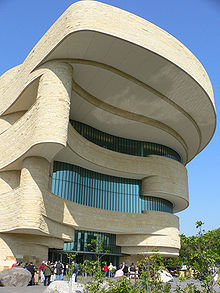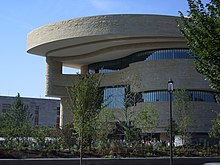National Museum of the American Indian
The National Museum of the American Indian ( NMAI ; German: National Museum of the Indians ) is a museum in Washington, DC ( USA ). It exhibits objects related to the life, language, literature, history and art of American Indians across America. It was brought into being in 1989 by a resolution of the US Congress and was also given a research assignment. The museum is operated under the auspices of the Smithsonian Institute . The museum has three complexes: one is the NMAI on the National Mall in Washington, which opened in 2004 on Fourth Street and Independence Avenue Southwest; the second is the George Gustav Heye Center inNew York City ; as well as the Cultural Resources Center in Suitland-Silver Hill in the state of Maryland , the actual research and storage building.
history
In October 1994, the NMAI's George Gustav Heye Center opened in the historic Alexander Hamilton US Custom House in Manhattan , New York . It serves as an exhibition and educational center about the Indian cultures. In addition to permanent and changing exhibitions, it offers space for music and dance performances, films and symposia.
1999 saw the opening of the Cultural Resources Center in Suitland , Maryland . It has facilities for the storage and protection of exhibits as well as for their cataloging and research. In addition, there is a library and a photo and paper archive in the center.
On September 21, 2004 the actual National Museum of the American Indian opened its doors in the capital of the USA . It is the largest museum in the world for Native American cultures. It cost $ 219 million to build, nearly half of which came from private donors. The state contributed $ 123 million.
From 1990 to 2007 lawyer W. Richard West, Jr. , a Cheyenne and Arapaho Indian from Oklahoma , was the director of the NMAI. Since December 2007, Kevin Gover, professor at Sandra Day O'Connor College of Law at Arizona State University , has been a Pawnee and Cheyenne director .
architecture
The NMAI in Washington was opened in September 2004 after 15 years of planning and construction. It is located on two acres near the Capitol on the National Mall . Indian planners such as the architects Douglas Cardinal from the Canadian Blackfoot and Johnpaul Jones from the Cherokee , but also Ramona Sakiestewa ( Hopi ) and Donna House ( Diné / Oneida ) were in charge of the planning and execution of the building. The result was an extraordinary museum building with a facade made of natural sandstone. It has neither corners nor edges. Instead, curvy lines emphasize the harmony with nature, in particular they are reminiscent of rocks that have been exposed to the effects of the wind for thousands of years. The entrance faces east, in the direction of the rising sun. A welcome wall greets visitors in 150 Indian languages.
Donna E. House designed the surroundings in such a way that their forms enter into an intensive, organic relationship with the exterior and interior of the building and at the same time represent the landscapes of America. With 33,000 trees and bushes, thirty uncut rocks ( Grandfather Rocks ), meadows, corn fields, streams and ponds, the open space is in tune with the dual character of the museum. This is complemented by an open-air theater.
Similarly, the Mitsitam Café, which offers traditional food, represents the various cultural areas of the Northern Woodlands , South America, the Northwest Coast , Central America and the Great Plains . However, the tribes of the southeast are hardly represented.
The five-story museum offers space for gatherings, performances, theater, but also fire pits and places for storytelling.
Collections
The starting point was the private collection of the wealthy New Yorker George Gustav Heye (1874–1957). The collectors based on this found themselves in a race with renowned collections all over the world when purchasing their objects. Most collectors were accordingly ruthless. Therefore, the subject of repatriation , i.e. the return of unjustly appropriated cultural goods, is an important issue today . Basically, human remains, grave goods, and religious and ceremonial artifacts are the property of a tribe. Illegally acquired objects must be returned if descendants or tribal groups so wish and if they can assert a cultural connection or legal claim.
The collections now include around 800,000 exhibits representing around 10,000 years of history from around a thousand Indian cultures across America. Only about one percent of this can be exhibited in Washington. 67% of the exhibits come from the USA, 3% from Canada and 30% from Central and South America. The Heye collection represents the basis of the exhibits.
The NMAI also exhibits objects of contemporary Indian art. It features a six-meter-high carved totem pole by the Tlingit , a bronze sculpture by the Pueblo and weaving by the Diné .
Native American Senator Ben Nighthorse Campbell , a chief of the Northern Cheyenne , donated his extensive art collection to the museum.
George Gustav Heye Center
The George Gustav Heye Center - named after George Gustav Heye (1874–1957) - occupies two floors of the Alexander Hamilton US Custom House in Lower Manhattan . The building, planned by the architect Cass Gilbert and completed in 1907, was executed in the Beaux Arts style. It is designated as a National Historic Landmark .
Cultural Resources Center
The Cultural Resources Center in Maryland is a nautilus- shaped building . In addition to the exhibits, it houses a library and a photo archive.
Web links
Individual evidence
- ↑ Kevin Gover, Arizona State University website ( memento of the original from December 12, 2009 in the Internet Archive ) Info: The archive link was automatically inserted and has not yet been checked. Please check the original and archive link according to the instructions and then remove this notice.
Coordinates: 38 ° 53 ′ 18 ″ N , 77 ° 0 ′ 59 ″ W.




